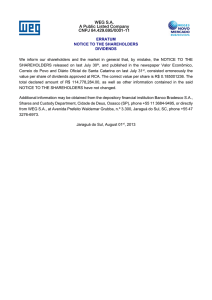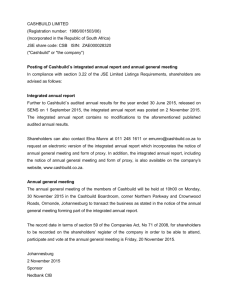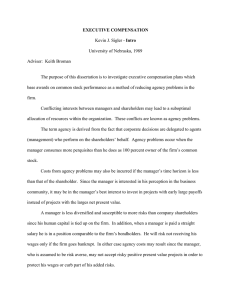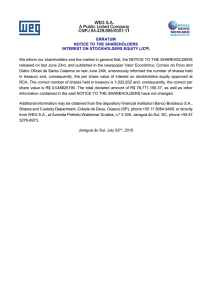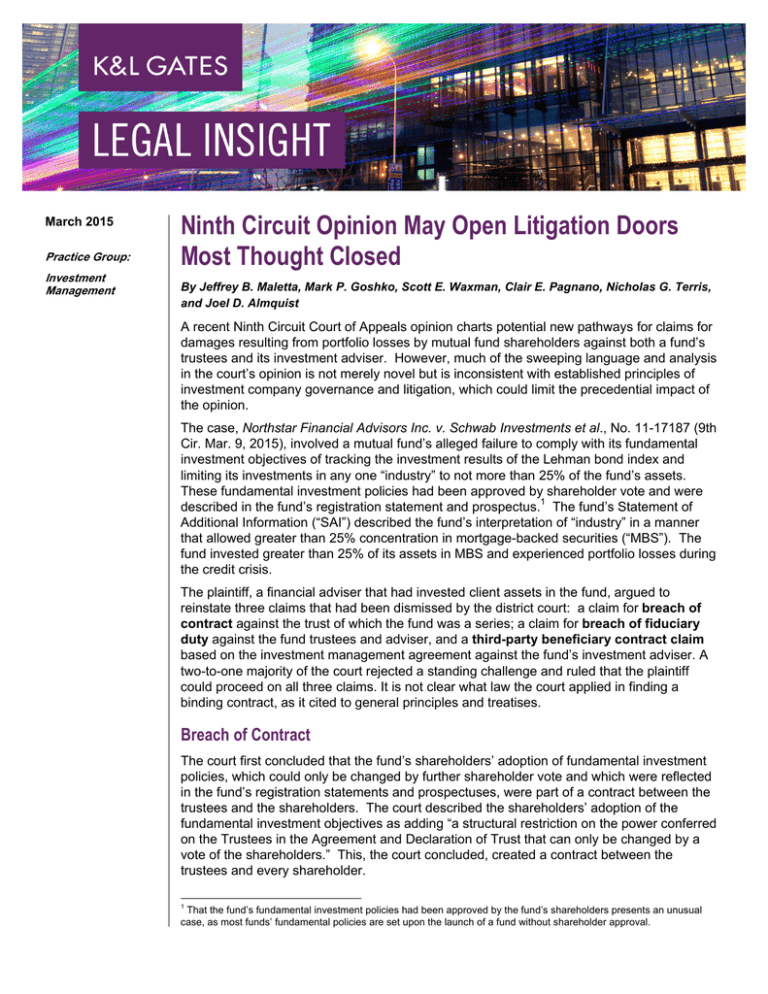
March 2015
Practice Group:
Investment
Management
Ninth Circuit Opinion May Open Litigation Doors
Most Thought Closed
By Jeffrey B. Maletta, Mark P. Goshko, Scott E. Waxman, Clair E. Pagnano, Nicholas G. Terris,
and Joel D. Almquist
A recent Ninth Circuit Court of Appeals opinion charts potential new pathways for claims for
damages resulting from portfolio losses by mutual fund shareholders against both a fund’s
trustees and its investment adviser. However, much of the sweeping language and analysis
in the court’s opinion is not merely novel but is inconsistent with established principles of
investment company governance and litigation, which could limit the precedential impact of
the opinion.
The case, Northstar Financial Advisors Inc. v. Schwab Investments et al., No. 11-17187 (9th
Cir. Mar. 9, 2015), involved a mutual fund’s alleged failure to comply with its fundamental
investment objectives of tracking the investment results of the Lehman bond index and
limiting its investments in any one “industry” to not more than 25% of the fund’s assets.
These fundamental investment policies had been approved by shareholder vote and were
described in the fund’s registration statement and prospectus.1 The fund’s Statement of
Additional Information (“SAI”) described the fund’s interpretation of “industry” in a manner
that allowed greater than 25% concentration in mortgage-backed securities (“MBS”). The
fund invested greater than 25% of its assets in MBS and experienced portfolio losses during
the credit crisis.
The plaintiff, a financial adviser that had invested client assets in the fund, argued to
reinstate three claims that had been dismissed by the district court: a claim for breach of
contract against the trust of which the fund was a series; a claim for breach of fiduciary
duty against the fund trustees and adviser, and a third-party beneficiary contract claim
based on the investment management agreement against the fund’s investment adviser. A
two-to-one majority of the court rejected a standing challenge and ruled that the plaintiff
could proceed on all three claims. It is not clear what law the court applied in finding a
binding contract, as it cited to general principles and treatises.
Breach of Contract
The court first concluded that the fund’s shareholders’ adoption of fundamental investment
policies, which could only be changed by further shareholder vote and which were reflected
in the fund’s registration statements and prospectuses, were part of a contract between the
trustees and the shareholders. The court described the shareholders’ adoption of the
fundamental investment objectives as adding “a structural restriction on the power conferred
on the Trustees in the Agreement and Declaration of Trust that can only be changed by a
vote of the shareholders.” This, the court concluded, created a contract between the
trustees and every shareholder.
1
That the fund’s fundamental investment policies had been approved by the fund’s shareholders presents an unusual
case, as most funds’ fundamental policies are set upon the launch of a fund without shareholder approval.
Ninth Circuit Opinion May Open Litigation Doors Most
Thought Closed
Further, the court found, anyone who invested in the fund after the fund’s registration
statement and prospectus began describing the fundamental policies was contractually
entitled to have his investment managed in accordance with those policies, unless the
shareholders voted to permit otherwise. When shareholders invested in the fund, according
to the court, they accepted the offer made by the fund in the fund’s prospectus. The court
noted that this is the same mechanism by which the shareholders became parties to the
fund’s Agreement and Declaration of Trust, which provided that “[e]very Shareholder by
virtue of having become a Shareholder shall be held to have expressly assented and agreed
to the terms hereof and to have become a party hereto.” The court also rejected the
defendants’ argument that the contract was modified by disclosure of the fund’s
interpretation of “industry” in the SAI, holding that the SAI did not provide adequate notice of
the interpretation. The court concluded that “it is reasonable to assume that there are many
ordinary shareholders who do not” read the SAI.
Fiduciary Duty Claim -- Direct vs. Derivative
The court’s analysis of the breach of fiduciary duty claim centered on whether the claim was
a derivative claim held by the fund or one that could be brought directly by shareholders.
The court rejected the defendants’ argument that this claim could only be brought
derivatively, saying that the argument “simply ignores the plain terms of the Agreement and
Declaration of Trust.” The trust instrument states expressly that:
The Trustees hereby declare that they will hold all cash, securities and other
assets, which they may from time to time acquire in any manner as Trustees
hereunder IN TRUST to manage and dispose of the same . . . for the pro rata
benefit of the holders from time to time of Shares in this Trust.
The fund is a series of a Massachusetts business trust, and the breach of fiduciary duty
claims were premised on Massachusetts law. The court then noted that it is unaware of any
Massachusetts case holding that agreements of this kind cannot be enforced directly by the
beneficiaries of a trust.2
In more sweeping language that would apply beyond the context of the particular trust or
Massachusetts law, the opinion then asserts that the distinction between direct and
derivative actions has little meaning in the context of mutual funds, noting that in a mutual
fund there is no business other than acquiring investments for the pro rata benefit of the
shareholders; any decrease in a mutual fund’s share price flows directly and immediately to
the shareholders. The court also reasoned that a direct action was appropriate where the
recovery available in a derivative action -- damages payable to the fund -- does not provide a
just measure of relief to the complaining shareholder.
The majority also expressed the view that the process for bringing derivative actions is inapt
in the mutual fund setting. In most cases, a shareholder seeking to sue in the name of a
corporation must first make a demand on the board. Demand allows disinterested directors
to exercise their authority over litigation on behalf of the fund and exercise their business
judgment in the best interest of the company. The court essentially dismissed the significant
2
However, Massachusetts courts have consistently held that shareholders in a Massachusetts business trust can assert
breach of fiduciary duty claims derivatively against the trustees. See, e.g., Peterson v. Hopson, 306 Mass. 597, 29
N.E.2d 140 (1940).
2
Ninth Circuit Opinion May Open Litigation Doors Most
Thought Closed
role of independent directors in the demand process and in fund governance generally by
describing mutual funds as “essentially puppets of the investment adviser.”
Third-Party Beneficiary
Finally, the court allowed the shareholders to bring a third-party beneficiary claim against the
fund’s investment adviser, based on the advisory agreement between the fund and the
adviser. That agreement specifies that it is governed by California law, and the court applied
that state’s law in analyzing the claim. The court found that the plaintiff had plausibly alleged
that the investment adviser understood that it was the intent of the fund to benefit the
shareholders of the fund. The contract between the adviser and the fund was required to be
approved by a majority of the fund’s shareholders. This, the court noted, establishes more
than a “remote” relationship on the part of the shareholders to the contract between the
adviser and the fund, and it indicates that the shareholders are the actual beneficiaries of the
advisory agreement.
Implications
The Northstar opinion is in many respects at odds with other cases as well as the general
principles, developed over and supported by years of consistent practice, providing the legal
framework for the operation and governance of mutual funds. If followed by other courts, it
could have adverse effects on all mutual funds, whether they are organized as
Massachusetts business trusts, Delaware statutory trusts or corporations. In its most
sweeping statements, the court discarded the fundamental distinction between claims that
may be brought directly by a shareholder, and derivative claims, which ordinarily may only be
brought with the authorization of an investment company’s board of directors or trustees.
The court essentially ruled that almost any alleged breach of duty by management or the
board that allegedly adversely affects NAV may be the subject of a direct action by
shareholders against the directors and the adviser. The rationales for this holding -- the
“direct” impact on shareholders through NAV and the view of funds as “puppets” of the
adviser -- have been rejected directly by numerous courts and are inconsistent with the
rulings of others, including U.S. Supreme Court cases that recognize the direct/derivative
distinction and the demand requirement in the mutual fund context.3 Similarly, Northstar’s
third-party beneficiary analysis offers another means of bypassing the established
procedures for raising and redressing alleged injuries to the fund from wrongful misconduct
of the adviser.
The direct contractual claims are similarly troubling, if less sweeping. The court found a
contract established by a combination of the shareholders’ voting rights with respect to
fundamental investment policies and the basic contractual offer-and-acceptance structure
presented by a prospectus’s securities offering. The court’s basis for this contract theory is
not grounded in generally accepted principles of mutual fund organization and governance,
but it may provide plaintiffs with a way to artfully plead as breach of contract claims,
misrepresentation claims that would otherwise be precluded by the Securities Litigation
Uniform Standards Act of 1998.
3
See, e.g., Burks v. Lasker, 441 U.S. 471 (1979)
3
Ninth Circuit Opinion May Open Litigation Doors Most
Thought Closed
Limited Impact?
Despite some of its startling language, the impact of the decision may be limited. The rulings
may be the subject of a request for reconsideration through rehearing or rehearing en banc,
or perhaps a petition for a writ of certiorari to the United States Supreme Court. In addition,
Northstar’s effect on other cases may be less dramatic. The court’s rulings are purportedly
based primarily on state law. Perhaps the most troubling ruling, on the breach of fiduciary
duty claim, is controlled by the law of Massachusetts. However, as a federal court, the Ninth
Circuit’s rulings on this issue are not binding on the Massachusetts courts, other state courts,
or even federal courts outside the Ninth Circuit. As noted above, other courts have reached
different conclusions on key issues, and courts in the future may well not accept the Ninth
Circuit’s reasoning. Massachusetts courts may effectively overturn these rulings, either in
cases brought in Massachusetts or under procedures (not used in Northstar) that permit
federal courts to certify questions to the Massachusetts Supreme Judicial Court for
resolution. Finally, as they did in the “Strougo” cases 15 years ago, state legislatures may
address the implications of court decisions that undermine generally accepted principles of
corporate governance. 4
Steps to Consider
Mutual fund complexes operating through trusts nonetheless may consider prophylactic
steps, such as a review of the provisions of their trust instruments, to determine the extent to
which the express terms of the instrument limit contractual rights and fiduciary duties. The
declaration of trust of a Massachusetts business trust can limit contractual rights and
fiduciary duties. “Trust fiduciary law is default law that the parties can alter to their needs.”5
The Northstar opinion itself quotes a commentator’s description of fiduciary duties as being
subject to modification by the parties to the trust: “The familiar standards of trust fiduciary
law protect trust beneficiaries of all sorts, regardless of whether the trust implements a gift or
a business deal (unless, of course, the terms of the transaction expressly contraindicate).”6
Similarly, the Delaware Statutory Trust Act specifically permits limitations of contractual
rights and fiduciary duties so long as these limitations do not eliminate the implied
contractual covenant of good faith and fair dealing.7 In addition, a Delaware statutory trust
can expressly limit liability for breach of contract and fiduciary duties to the extent that these
limitations do not limit or eliminate liability for any act or omission that constitutes a bad-faith
violation of the implied contractual covenant of good faith and fair dealing.8
Investment company advisers and boards may anticipate the possibility of more litigation,
particularly in states covered by the Ninth Circuit, as the plaintiffs’ bar seeks to take
advantage of the Ninth Circuit’s expansive opinion.
4
See, e.g., Strougo v. BEA Associates, 188 F.Supp.2d 373 (S.D.N.Y 2002) and Mass.G.L. c. 182 § 2B.
John H. Langbein, The Secret Life of the Trust: The Trust as an Instrument of Commerce, 107 Yale L.J. 165, 183 (1997).
6
Id. at 166.
7
Delaware Statutory Trust Act, 12 Del. C. § 3806(c).
8
Delaware Statutory Trust Act, 12 Del. C. § 3806(e).
5
4
Ninth Circuit Opinion May Open Litigation Doors Most
Thought Closed
Authors:
Jeffrey B. Maletta
Mark P. Goshko
Scott E. Waxman
jeffrey.maletta@klgates.com
+1.202.778.9062
mark.goshko@klgates.com
+1.617.261.3163
scott.waxman@klgates.com
+1.302.416.7070
Clair E. Pagnano
Nicholas G. Terris
Joel D. Almquist
clair.pagnano@klgates.com
+1.617.261.3246
nicholas.terris@klgates.com
+1.202.778.9408
joel.almquist@klgates.com
+1.617.261.3104
Anchorage Austin Beijing Berlin Boston Brisbane Brussels Charleston Charlotte Chicago Dallas Doha Dubai Fort Worth Frankfurt
Harrisburg Hong Kong Houston London Los Angeles Melbourne Miami Milan Moscow Newark New York Orange County Palo Alto Paris
Perth Pittsburgh Portland Raleigh Research Triangle Park San Francisco São Paulo Seattle Seoul Shanghai Singapore Spokane
Sydney Taipei Tokyo Warsaw Washington, D.C. Wilmington
K&L Gates comprises more than 2,000 lawyers globally who practice in fully integrated offices located on five
continents. The firm represents leading multinational corporations, growth and middle-market companies, capital
markets participants and entrepreneurs in every major industry group as well as public sector entities, educational
institutions, philanthropic organizations and individuals. For more information about K&L Gates or its locations,
practices and registrations, visit www.klgates.com.
This publication is for informational purposes and does not contain or convey legal advice. The information herein should not be used or relied upon in
regard to any particular facts or circumstances without first consulting a lawyer.
© 2015 K&L Gates LLP. All Rights Reserved.
5





